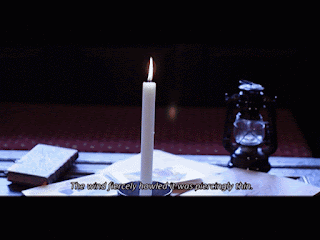I have done a lot of work to create this project and although I can see which bits I can improve to make the story even better, I am still proud of it. I wrote the script for it, draw a storyboard, did the camerawork and directing, designed and etc.
Two "films" are combined into one: the story itself is accompanied by a stop-motion part. I made this decision as stop-motion can remind the audience about paintings and awoke a feeling that everything in it is an illusion or a memory.
Cinematographic
logline: Something out of their expectations.
The
premise: A drama with gothic elements, telling about two scientists who become
extremely interested in a story of an artist living ages ago. As her paintings
have disappeared with her, nobody can touch or even get to know her art closer…
or can? Is there still any purpose in it if it feels like it has never existed?
Can science and art understand each other? The characters of this story try to
answer these questions.
The audience watches the film within a certain perspective, point of view (POV). The way it sees it is a decision made by the filmmaker, who wants to tell the story. Forgotten tells the story from two points of views: from the perspective of Matthew and Piter as the audience should experience the same artistic awake they do, and from the perspective of something as powerful as Time. The audience has more information rather than the two present characters: it knows how Lily looks like, it knows that she was called a witch and therefore has some thoughts about the reason she died (maybe she was killed and the fire was neither a mistake nor accident but a directed murder committed by the people afraid of her), it sees that Piter sits on the same tree Lily sat before… At the same time the audience watches through Piter’s eyes as it:
- Cannot see anything on the wall when Matthew can.
- Sees paintings simultaneously with Piter in the end.
- Can hear Piter’s voice over aka his thoughts.
Therefore, the storytelling mode of narrative can be considered as the first person one, at the same time there is a third person mode of narrative, appearing with memories of Lily, quite subjective and placed behind the curtain. Who does watch Lily when she is in her house or outside of it? Who does see her drawing or is it her POV? Then who receives her memories? Has they been collected somewhere and being hold in a bottle to be splashed on the audience when they hear her story to make assumptions on what has happened years ago? There is a film called The Book Thief (2013, directed by Brian Percival), which has a voice representing Death, who watches at people from above and chooses people to follow. And Forgotten has a similar sense of someone following the characters, listening to them.
The story information received by the audience is given in portions and doses. In the beginning the topic is established, but rather slowly. The main idea was to surround the audience with small stylistic decorations to pour on its head the final information about the story purpose when the audience is ready and swims in the right atmosphere. This atmosphere is composed from specific sets:
- Nature, the establishing shot.
- Wall and stone, focusing on the discussion object.
- Matthew and Piter representing present.
- Shots of Lily presenting a gothic style.
- Shots of drawing and paint to add the artistic atmosphere.
- Shots of red paint to add some anxiety.
- Ballet shots and books’ pages shots to open Lily’s character more, showing her interests.
Forgotten can also be divided into three acts:
1. Introducing the main characters with the voice over.
Creative the necessary environment with the establishing shot of the field.
The discussion of the problem the main characters have.
And introducing their relationship via the use of phrases like “I don’t know why you’ve taken me here” showing they know each other for a long time.
2. The confrontation crisis is the split between the characters when Piter decides to think over the problem on his own (Voice-over part).
The shots also give more information about the artist.
It results into the crescendo with the poem scene when all information is given.
3. The resolution is the summing up all thoughts the characters have.
But moreover they are going to have a “gift of the Magi” for this – the opportunity to see the ghost paintings.
Returning to the point of time, place, and action. Although the place remains the same – the ruins or the house as it was ages ago, the time changes. The storyline begins with the present, now (early evening), in the ruins in the middle of nowhere to create a sense that it can happen anywhere.
Memories interrupt the narrative several times as they are too powerful for the present: one cannot stand but has to return to the times when Lily was alive, let’s call it the energy of the past. And because this place, this wall, and these ruins are full of this energy as she lived and created her pictures there, this energy is awaken and tries to get between the shots, between the dialogue’s parts.




No comments:
Post a Comment